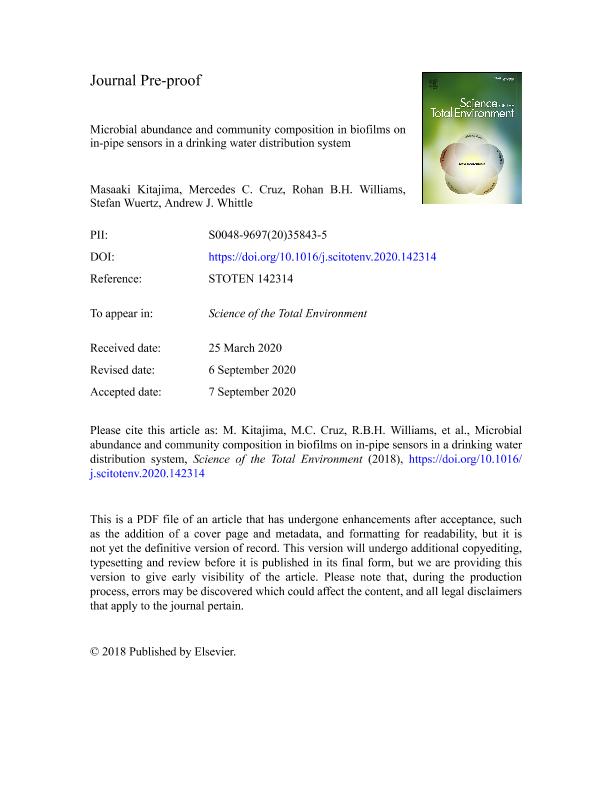Artículo
Collecting biofilm samples from drinking water distribution systems (DWDSs) is challenging due to limited access to the pipes during regular operations. We report here the analysis of microbial communities in biofilm and water samples collected from sensors installed in a DWDS where monochloramine is used as a residual disinfectant. A total of 52 biofilm samples and 14 bulk water samples were collected from 17 pipe sections representing different water ages. Prokaryotic genome copies (bacterial and archaeal 16S rRNA genes, Mycobacterium spp., ammonia-oxidizing bacteria (AOB), and cyanobacteria) were quantified with droplet digital PCR, which revealed the abundance of these genes in both biofilm and water samples. Prokaryotic 16S rRNA gene sequencing analysis was carried out for a subset of the samples (12 samples from four sites). Mycobacterium and AOB species were dominant in the DWDS sections with low water age and sufficient residual monochloramine, whereas Nitrospira species (nitrite-oxidizing bacteria) dominated in the sections with higher water age and depleted monochloramine level, suggesting the occurrence of nitrification in the studied DWDS. The present study provides novel information on the abundance and identity of prokaryotes in biofilms and water in a full-scale operational DWDS. Collecting biofilm samples from drinking water distribution systems (DWDSs) is challenging due to limited access to the pipes during regular operations. We report here the analysis of microbial communities in biofilm and water samples collected from sensors installed in a DWDS where monochloramine is used as a residual disinfectant. A total of 52 biofilm samples and 14 bulk water samples were collected from 17 pipe sections representing different water ages. Prokaryotic genome copies (bacterial and archaeal 16S rRNA genes, Mycobacterium spp., ammonia-oxidizing bacteria (AOB), and cyanobacteria) were quantified with droplet digital PCR, which revealed the abundance of these genes in both biofilm and water samples. Prokaryotic 16S rRNA gene sequencing analysis was carried out for a subset of the samples (12 samples from four sites). Mycobacterium and AOB species were dominant in the DWDS sections with low water age and sufficient residual monochloramine, whereas Nitrospira species (nitrite-oxidizing bacteria) dominated in the sections with higher water age and depleted monochloramine level, suggesting the occurrence of nitrification in the studied DWDS. The present study provides novel information on the abundance and identity of prokaryotes in biofilms and water in a full-scale operational DWDS
Microbial abundance and community composition in biofilms on in-pipe sensors in a drinking water distribution system
Kitajima, Masaaki; Cruz, Mercedes Cecilia ; Williams, Rohan Benjamin Hugh; Wuertz, Stefan; Whittle, Andrew J.
; Williams, Rohan Benjamin Hugh; Wuertz, Stefan; Whittle, Andrew J.
 ; Williams, Rohan Benjamin Hugh; Wuertz, Stefan; Whittle, Andrew J.
; Williams, Rohan Benjamin Hugh; Wuertz, Stefan; Whittle, Andrew J.
Fecha de publicación:
09/2020
Editorial:
Elsevier
Revista:
Science of the Total Environment
ISSN:
0048-9697
Idioma:
Inglés
Tipo de recurso:
Artículo publicado
Clasificación temática:
Resumen
Palabras clave:
WATER DISTRIBUTION SYSTEM
,
BIOFILM
,
WATER QUALITY
,
16S RNA GENE SEQUENCING
Archivos asociados
Licencia
Identificadores
Colecciones
Articulos(INIQUI)
Articulos de INST.DE INVEST.PARA LA INDUSTRIA QUIMICA (I)
Articulos de INST.DE INVEST.PARA LA INDUSTRIA QUIMICA (I)
Citación
Kitajima, Masaaki; Cruz, Mercedes Cecilia; Williams, Rohan Benjamin Hugh; Wuertz, Stefan; Whittle, Andrew J.; Microbial abundance and community composition in biofilms on in-pipe sensors in a drinking water distribution system; Elsevier; Science of the Total Environment; 766; 142314; 9-2020; 1-37
Compartir
Altmétricas



